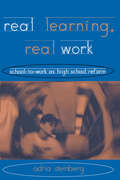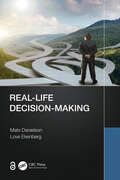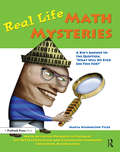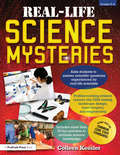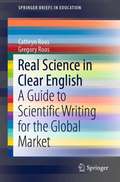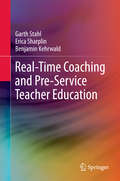- Table View
- List View
Real Learning, Real Work: School-to-Work As High School Reform
by Adria SteinbergFirst Published in 1998. Routledge is an imprint of Taylor & Francis, an informa company.
Real-Life Decision-Making
by Mats Danielson Love EkenbergHave you ever experienced a decision situation that was hard to come to grips with? Did you ever feel a need to improve your decision-making skills? Is this something where you feel that you have not learned enough practical and useful methods? In that case, you are not alone! Even though decision-making is both considered and actually is a very important skill in modern work-life as well as in private life, these skills are not to any reasonable extent taught in schools at any level. No wonder many people do indeed feel the need to improve but have a hard time finding out how. This book is an attempt to remedy this shortcoming of our educational systems and possibly also of our common, partly intuition-based, decision culture. Intuition is not at all bad, quite the contrary, but it has to co-exist with rationality. We will show you how.Methods for decision-making should be of prime concern to any individual or organisation, even if the decision processes are not always explicitly or even consciously formulated. All kinds of organisations, as well as individuals, must continuously make decisions of the most varied nature in order to prosper and attain their objectives. A large part of the time spent in any organisation, not least at management levels, is spent gathering, processing, and compiling information for the purpose of making decisions supported by that information. The same interest has hitherto not been shown for individual decision-making, even though large gains would also be obtained at a personal level if important personal decisions were better deliberated. This book aims at changing that and thus attends to both categories of decision-makers.This book will take you through a journey starting with some history of decision-making and analysis and then go through easy-to-learn ways of structuring decision information and methods for analysing the decision situations, beginning with simple decision situations and then moving on to progressively harder ones, but never losing sight of the overarching goal that the reader should be able to follow the progression and being able to carry out similar decision analyses in real-life situations.The Open Access version of this book, available at www.taylorfrancis.com, has been made available under a Creative Commons Attribution-Non Commercial-No Derivatives 4.0 license.
Real-Life Decision-Making
by Mats Danielson Love EkenbergHave you ever experienced a decision situation that was hard to come to grips with? Did you ever feel a need to improve your decision-making skills? Is this something where you feel that you have not learned enough practical and useful methods? In that case, you are not alone! Even though decision-making is both considered and actually is a very important skill in modern work-life as well as in private life, these skills are not to any reasonable extent taught in schools at any level. No wonder many people do indeed feel the need to improve but have a hard time finding out how. This book is an attempt to remedy this shortcoming of our educational systems and possibly also of our common, partly intuition-based, decision culture. Intuition is not at all bad, quite the contrary, but it has to co-exist with rationality. We will show you how.Methods for decision-making should be of prime concern to any individual or organisation, even if the decision processes are not always explicitly or even consciously formulated. All kinds of organisations, as well as individuals, must continuously make decisions of the most varied nature in order to prosper and attain their objectives. A large part of the time spent in any organisation, not least at management levels, is spent gathering, processing, and compiling information for the purpose of making decisions supported by that information. The same interest has hitherto not been shown for individual decision-making, even though large gains would also be obtained at a personal level if important personal decisions were better deliberated. This book aims at changing that and thus attends to both categories of decision-makers.This book will take you through a journey starting with some history of decision-making and analysis and then go through easy-to-learn ways of structuring decision information and methods for analysing the decision situations, beginning with simple decision situations and then moving on to progressively harder ones, but never losing sight of the overarching goal that the reader should be able to follow the progression and being able to carry out similar decision analyses in real-life situations.The Open Access version of this book, available at www.taylorfrancis.com, has been made available under a Creative Commons Attribution-Non Commercial-No Derivatives 4.0 license.
Real Life Heroes: Toolkit for Treating Traumatic Stress in Children and Families, 2nd Edition
by Richard KaganReal Life Heroes: Toolkit for Treating Traumatic Stress in Children and Families, Second Edition is an organized and easy-to-use reference for practitioners providing therapy to children and caregivers with traumatic stress. This step-by-step guide is an accompanying text to the workbook Real Life Heroes: A Life Story Book for Children, Third Edition and provides professionals with structured tools for helping children to reintegrate painful memories and to foster healing from traumatic experiences. The book is a go-to resource for practitioners in child and family service agencies and treatment centers to implement trauma-informed, resiliency-centered and evidence-supported services for children with traumatic stress.
Real Life Heroes: Toolkit for Treating Traumatic Stress in Children and Families, 2nd Edition
by Richard KaganReal Life Heroes: Toolkit for Treating Traumatic Stress in Children and Families, Second Edition is an organized and easy-to-use reference for practitioners providing therapy to children and caregivers with traumatic stress. This step-by-step guide is an accompanying text to the workbook Real Life Heroes: A Life Story Book for Children, Third Edition and provides professionals with structured tools for helping children to reintegrate painful memories and to foster healing from traumatic experiences. The book is a go-to resource for practitioners in child and family service agencies and treatment centers to implement trauma-informed, resiliency-centered and evidence-supported services for children with traumatic stress.
Real Life Math Mysteries: A Kid's Answer to the Question, "What Will We Ever Use This For?" (Grades 4-10)
by Marya Washington TylerZookeeper, horse stable owner, archaeologist, lawyer, pilot, fireman, newspaper editor, dairy farmer, arson detective . . . these are just a few of the real people who, in their own words, share their own daily encounters with mathematics. How much lettuce does the Pizza Hut manager need to order for next week? How many rose bushes can a gardener fit around a wading pool? How many fire hoses will be needed to extinguish the fire? Your students will be amazed at the real-life math faced by truck drivers, disc jockeys, farmers, and car mechanics.Real Life Math Mysteries introduces students to math in the real world through a series of problems drawn from a vast array of community leaders, business professionals, and city officials. The problems are designed to stimulate students' creative thinking and teach the value of math in a real-world setting.Each concise and clear problem is provided on a blackline master and includes problem-solving suggestions for students with a comprehensive answer key. The problems are tied to the guidelines for math instruction from the National Council of Teachers of Mathematics. This book will get students thinking about the mathematics all around them.Make math last a lifetime. Students will delight in the real-life approach to math as they realize that they will use math skills over and over again in whatever vocation they choose. Make math an exciting experience that children realize will last a lifetime.More books that make math fun for students include Extreme Math, It's Alive!, and It's Alive! And Kicking!.Grades 4-10
Real Life Math Mysteries: A Kid's Answer to the Question, "What Will We Ever Use This For?" (Grades 4-10)
by Marya Washington TylerZookeeper, horse stable owner, archaeologist, lawyer, pilot, fireman, newspaper editor, dairy farmer, arson detective . . . these are just a few of the real people who, in their own words, share their own daily encounters with mathematics. How much lettuce does the Pizza Hut manager need to order for next week? How many rose bushes can a gardener fit around a wading pool? How many fire hoses will be needed to extinguish the fire? Your students will be amazed at the real-life math faced by truck drivers, disc jockeys, farmers, and car mechanics.Real Life Math Mysteries introduces students to math in the real world through a series of problems drawn from a vast array of community leaders, business professionals, and city officials. The problems are designed to stimulate students' creative thinking and teach the value of math in a real-world setting.Each concise and clear problem is provided on a blackline master and includes problem-solving suggestions for students with a comprehensive answer key. The problems are tied to the guidelines for math instruction from the National Council of Teachers of Mathematics. This book will get students thinking about the mathematics all around them.Make math last a lifetime. Students will delight in the real-life approach to math as they realize that they will use math skills over and over again in whatever vocation they choose. Make math an exciting experience that children realize will last a lifetime.More books that make math fun for students include Extreme Math, It's Alive!, and It's Alive! And Kicking!.Grades 4-10
Real-Life Science Mysteries: Grades 5-8
by Colleen KesslerReal-Life Science Mysteries puts an exciting new spin on scientific thinking by profiling real-life scientists, showing students in grades 5-8 ways they can use science in their everyday lives. From a biologist studying the habits of garter snakes in Manitoba, Canada, to a landscape designer and greenhouse owner in Ohio, the scientists in this book share information and solutions to the thorniest problems they face in their scientific careers.With the more than 30 activities included in Real-Life Science Mysteries, students will be required to try their hand at solving common science problems and performing experiments while learning about real people from diverse backgrounds, all of whom share a love for discovering how they work, why things work, and how they can work better. This book is perfect for any science classroom or young scientists looking to increase their knowledge!Grades 5-8
Real-Life Science Mysteries: Grades 5-8
by Colleen KesslerReal-Life Science Mysteries puts an exciting new spin on scientific thinking by profiling real-life scientists, showing students in grades 5-8 ways they can use science in their everyday lives. From a biologist studying the habits of garter snakes in Manitoba, Canada, to a landscape designer and greenhouse owner in Ohio, the scientists in this book share information and solutions to the thorniest problems they face in their scientific careers.With the more than 30 activities included in Real-Life Science Mysteries, students will be required to try their hand at solving common science problems and performing experiments while learning about real people from diverse backgrounds, all of whom share a love for discovering how they work, why things work, and how they can work better. This book is perfect for any science classroom or young scientists looking to increase their knowledge!Grades 5-8
The Real MCTS SQL Server 2008 Exam 70-432 Prep Kit: Database Implementation and Maintenance
by Mark HorningerSQL Server 2008 is the latest update to Microsoft's flagship database management system. This is the largest update since SQL Server 2005. SQL Server 2008 is a much more significant update than SQL Server 2005, because it brings increased ability to deliver data across more platforms, and thus many different types of devices. New functionality also allows for easy storage and retrieval of digitized images and video. These attributes address the recent explosion in the popularity of web-based video and server and desktop virtualization.The Real MCTS SQL Server 2008 Exam 70-432 Prep Kit prepares readers for the Microsoft Certified Technology Specialist exam: SQL Server 2008, Implementation and Maintenance.This is The 'Real' Microsoft Exam Prep Kit, and provides the reader with independent and unbiased exam tips and warnings everything they need to know to ensure certification success.Authored by Mark Horninger, a nationally recognized leader in SQL Server with over 50 Microsoft certifications to his credit; Mark knows what it takes to successfully navigate Microsoft exams.
A Real Part to Play: A resource pack for involving young people in community regeneration (PDF)
by Elin Stefansson Ruth Dalzell Dalzell Ruth DalzellA Real Part to Play follows the evolutionary stages of project development, from planning children and young people's involvement to working with them and evaluating the results of a specific project. It considers the context of involving children and young people in community regeneration and possible problems. It includes examples of good practice, practical tips, checklists, advice and activities. If you are a professional working in community regeneration, or simply want to increase children and young people's involvement in your community, this manual provides inspiration and a starting point for discussion. The material can be modified and developed to make it useful for your community.
Real Revision: Authors' Strategies to Share with Student Writers
by Kate MessnerHow do you show students that revision is more than a classroom exercise to please the teacher? Take them into the real world of writing for publication. In Real Revision, award-winning author and teacher Kate Messner demystifies the revision process for teachers and students alike and provides tried-and-true revision strategies, field tested by students' favorite authors. Kate takes us on a behind-the-scenes look at how more than thirty-five authorsincluding Julie Berry, Watt Key, Loree Griffin Burns , Jane Yolen, Lisa Schroeder, Suzanne Selfors, Eric Luper, Danette Haworth, and Kathi Appeltrevise their works, often many times over, before they appear on library and bookstore shelves. Using successful strategies from her own classroom, Kate teaches how authors use research, brainstorming, and planning as revision tools; how they revise to add detail and make characters stronger; and how students can use those same techniques for all kinds of writing in the classroom. Real Revision features dozens of reproducible 'mentor author pages, with quotes from the authors about their revision processes, and includes related classroom-ready activities. For any teacher who wants to produce strong real-world writers, Real Revision will infuse the classroom with new energy as students use mentor authors as models for their own revision and writing.
Real Revision: Authors' Strategies to Share with Student Writers
by Kate MessnerHow do you show students that revision is more than a classroom exercise to please the teacher? Take them into the real world of writing for publication. In Real Revision, award-winning author and teacher Kate Messner demystifies the revision process for teachers and students alike and provides tried-and-true revision strategies, field tested by students' favorite authors. Kate takes us on a behind-the-scenes look at how more than thirty-five authorsincluding Julie Berry, Watt Key, Loree Griffin Burns , Jane Yolen, Lisa Schroeder, Suzanne Selfors, Eric Luper, Danette Haworth, and Kathi Appeltrevise their works, often many times over, before they appear on library and bookstore shelves. Using successful strategies from her own classroom, Kate teaches how authors use research, brainstorming, and planning as revision tools; how they revise to add detail and make characters stronger; and how students can use those same techniques for all kinds of writing in the classroom. Real Revision features dozens of reproducible 'mentor author pages, with quotes from the authors about their revision processes, and includes related classroom-ready activities. For any teacher who wants to produce strong real-world writers, Real Revision will infuse the classroom with new energy as students use mentor authors as models for their own revision and writing.
Real Science in Clear English: A Guide to Scientific Writing for the Global Market (SpringerBriefs in Education)
by Cathryn Roos Gregory RoosThis book is a timely go-to resource for any professionals wishing to communicate with the growing number of readers whose first language is not English. It highlights the potential language difficulties these readers face, and provides guidelines and tools for overcoming them. The guidelines show how to convey complicated information clearly without affecting the integrity of the subject matter, while the practical ‘before’ and ‘after’ examples clearly illustrate how using these guidelines and improves scientific texts. The book also includes text evaluation tools that allow writers to rapidly assess the readability of their materials. It is based on theory and the authors’ extensive experience in producing highly readable English texts for L2 readers who struggle with materials that were originally prepared for L1 readers.
Real Teachers, Real Challenges, Real Solutions: 25 Ways to Handle the Challenges of the Classroom Effectively
by Elizabeth Breaux Annette BreauxThis book helps new and experienced teachers find solutions to common classroom challenges. It presents 25 real scenarios along with “What’s Effective”, “What’s NOT Effective,” and “Bottom Line” strategies for handling the most common teacher challenges. Ideal for high-interest staff development workshops or new teacher induction programs, this book shows teachers how to get students to do what you want them to do; deal with disrespectful student behaviors and handle “I don’t care” attitudes; deal with parents and difficult co-workers; and solve other common teaching challenges.REAL Teachers, REAL Challenges, REAL Solutions: 25 Ways to Handle the Challenges of the Classroom Effectively is for teachers who need common-sense answers to common teaching challenges, experienced teachers who seek to become even more effective, and teachers who believe in treating their students with professionalism and dignity.
Real Teachers, Real Challenges, Real Solutions: 25 Ways to Handle the Challenges of the Classroom Effectively
by Elizabeth Breaux Annette BreauxThis book helps new and experienced teachers find solutions to common classroom challenges. It presents 25 real scenarios along with “What’s Effective”, “What’s NOT Effective,” and “Bottom Line” strategies for handling the most common teacher challenges. Ideal for high-interest staff development workshops or new teacher induction programs, this book shows teachers how to get students to do what you want them to do; deal with disrespectful student behaviors and handle “I don’t care” attitudes; deal with parents and difficult co-workers; and solve other common teaching challenges.REAL Teachers, REAL Challenges, REAL Solutions: 25 Ways to Handle the Challenges of the Classroom Effectively is for teachers who need common-sense answers to common teaching challenges, experienced teachers who seek to become even more effective, and teachers who believe in treating their students with professionalism and dignity.
Real-Time Coaching and Pre-Service Teacher Education (SpringerBriefs in Education)
by Garth Stahl Erica Sharplin Benjamin KehrwaldThis book details the findings of a small-scale research study on the use of real-time coaching in pre-service teacher education, founded upon the nexus of teacher education, mentoring, immediate feedback, teacher effectiveness, technology-enhanced learning and innovative approaches to developing better teaching practices. The book includes a robust literature review summarizing the scholarship on coaching models used in teacher education. The authors explore how real-time coaching, as a specific approach, has the potential to address persistent problems in teacher education and early career teacher performance in the areas of teachers’ growth mindset, teacher resilience and disjuncture in applying theory to practice. The scholarship allows readers to gain a better understanding of the history of coaching in teacher training, and the capacity of real-time coaching, specifically, in pre-service teacher training told through the words of participants.
Real-Time Student Assessment: Meeting the Imperative for Improved Time to Degree, Closing the Opportunity Gap, and Assuring Student Competencies for 21st-Century Needs
by Peggy L. MakiThis book challenges institutions and their programs to prioritize the use of chronological assessment results to benefit enrolled students in comparison with the more common practice of prolonged assessment cycles that generally benefit future students. Peggy Maki advocates for real-time assessment processes to identify patterns of underperformance and obstacles that require timely interventions for enrolled students to succeed. In tandem with the sets of educational practices and policies that many institutions have now undertaken to close achievement and graduation rates across our diverse student demographics, such as developing clear degree pathways, she calls on all higher education providers – if they are to remain relevant and meet their social purpose in our complex world – to urgently recalibrate their assessment processes to focus on currently enrolled students’ progress towards achieving a high-quality degree, regardless of when they matriculate or re-enter higher education. She demonstrates that we already have sufficient examples and evidence to implement real-time assessment of students as they progress through their studies. She draws on the practices of specialized accredited programs, such as those in the professions that assess in real time; on the experiences of institutions that have adopted competency-based education; and on the affordances of technologies that now provide faculty and students with up-to-the-minute diagnostics. She identifies the six principles necessary to implement a real-time assessment process, illustrated by case studies of how campuses have operationalized them to advance students’ equitable progress towards achieving a high-quality degree; and demonstrates the benefits of real-time assessment compared to more future-oriented processes, among which is engaging students in reflecting on their own progress along their degree pathways.She advocates for the use of well documented national outcomes-based frameworks such as Liberal Education and America’s Promise (LEAP), its aligned Valid Assessment of Learning in Undergraduate Education scoring rubrics ( VALUE), the Degree Qualifications Profile, and discipline-based outcomes assessments to ensure high-quality degrees that meet well-defined standards and criteria. She also identifies how data systems and technological developments help to monitor closely and respond in time to students’ patterns of underperformance.The book is an urgent call for higher education to achieve the values of equity, transparency and quality it espouses; and ensure that all students graduate in a timely fashion with the competencies they need to be active and productive citizens.
Real-Time Student Assessment: Meeting the Imperative for Improved Time to Degree, Closing the Opportunity Gap, and Assuring Student Competencies for 21st-Century Needs
by Peggy L. MakiThis book challenges institutions and their programs to prioritize the use of chronological assessment results to benefit enrolled students in comparison with the more common practice of prolonged assessment cycles that generally benefit future students. Peggy Maki advocates for real-time assessment processes to identify patterns of underperformance and obstacles that require timely interventions for enrolled students to succeed. In tandem with the sets of educational practices and policies that many institutions have now undertaken to close achievement and graduation rates across our diverse student demographics, such as developing clear degree pathways, she calls on all higher education providers – if they are to remain relevant and meet their social purpose in our complex world – to urgently recalibrate their assessment processes to focus on currently enrolled students’ progress towards achieving a high-quality degree, regardless of when they matriculate or re-enter higher education. She demonstrates that we already have sufficient examples and evidence to implement real-time assessment of students as they progress through their studies. She draws on the practices of specialized accredited programs, such as those in the professions that assess in real time; on the experiences of institutions that have adopted competency-based education; and on the affordances of technologies that now provide faculty and students with up-to-the-minute diagnostics. She identifies the six principles necessary to implement a real-time assessment process, illustrated by case studies of how campuses have operationalized them to advance students’ equitable progress towards achieving a high-quality degree; and demonstrates the benefits of real-time assessment compared to more future-oriented processes, among which is engaging students in reflecting on their own progress along their degree pathways.She advocates for the use of well documented national outcomes-based frameworks such as Liberal Education and America’s Promise (LEAP), its aligned Valid Assessment of Learning in Undergraduate Education scoring rubrics ( VALUE), the Degree Qualifications Profile, and discipline-based outcomes assessments to ensure high-quality degrees that meet well-defined standards and criteria. She also identifies how data systems and technological developments help to monitor closely and respond in time to students’ patterns of underperformance.The book is an urgent call for higher education to achieve the values of equity, transparency and quality it espouses; and ensure that all students graduate in a timely fashion with the competencies they need to be active and productive citizens.
Real World Careers: Why College Is Not the Only Path to Becoming Rich
by Betsy CummingsThe most provocative business book of the year is the ultimate guide to having a great career and financial security -- even if you haven't graduated with a college degree.With so much emphasis in society on the importance of finishing college, Real World Careers is filled with inspirational stories of people who skipped college or left early, launched successful careers and were able to accelerate their earnings potential. From information technology to construction, blue collar to business startups, many jobs offer excellent pay and personal fulfillment and don't require a college degree.Written by an award-winning business journalist, this book also provides information on:the vocational and trade schools that are a faster,more strategic road to landing workflexible and incentive-based careers that don't require a college degreethe option of entrepreneurshipovercoming preconceptionsand much more.
A Real-World Guide to Restorative Justice in Schools: Practical Philosophy, Useful Tools, and True Stories
by Nicholas Bradford David LeSalThis book is designed to help you navigate the challenges and joys of building and maintaining a healthy restorative ecosystem in your school, while providing concrete tools and real-world stories to guide you through the process.Traditional methods of discipline are commonly found to be ineffective, and this book shows how restorative justice can benefit schools in a huge variety of ways, such as decreasing the need for suspensions, increasing academic outcomes, and improving the health of your whole school community.Written by the founder and the education director of the National Center for Restorative Justice, each and every chapter is packed with expertise on everything from carrying out the stages of a restorative circle to understanding the importance of conflict. The authors pull no punches in showing that this work is not always easy, but their passion for restorative justice shines out of every page, demonstrating just how valuable this approach can be in bringing the absolute best out of your students and school.
A Real-World Guide to Restorative Justice in Schools: Practical Philosophy, Useful Tools, and True Stories
by Nicholas Bradford David LeSalThis book is designed to help you navigate the challenges and joys of building and maintaining a healthy restorative ecosystem in your school, while providing concrete tools and real-world stories to guide you through the process.Traditional methods of discipline are commonly found to be ineffective, and this book shows how restorative justice can benefit schools in a huge variety of ways, such as decreasing the need for suspensions, increasing academic outcomes, and improving the health of your whole school community.Written by the founder and the education director of the National Center for Restorative Justice, each and every chapter is packed with expertise on everything from carrying out the stages of a restorative circle to understanding the importance of conflict. The authors pull no punches in showing that this work is not always easy, but their passion for restorative justice shines out of every page, demonstrating just how valuable this approach can be in bringing the absolute best out of your students and school.
Real World Instructional Design: An Iterative Approach to Designing Learning Experiences
by Katherine Cennamo Debby KalkAn ideal textbook for instructional designers in training, Real World Instructional Design emphasizes the collaborative, iterative nature of instructional design. Positing instructional design as a process of simultaneous rather than sequential tasks with learner-centered outcomes, this volume engages with the essential building blocks of systematically designed instruction: learner needs and characteristics, goals and objectives, instructional activities, assessments, and formative evaluations. Key features include a Designer’s Toolkit that includes tips and approaches that practitioners use in their work; vignettes and narrative case studies that illustrate the complexities and iterative nature of instructional design; and forms, templates, and questionnaires to support students in applying the chapter content. With updated examples, this streamlined second edition presents a timeless approach to instructional design.
Real World Instructional Design: An Iterative Approach to Designing Learning Experiences
by Katherine Cennamo Debby KalkAn ideal textbook for instructional designers in training, Real World Instructional Design emphasizes the collaborative, iterative nature of instructional design. Positing instructional design as a process of simultaneous rather than sequential tasks with learner-centered outcomes, this volume engages with the essential building blocks of systematically designed instruction: learner needs and characteristics, goals and objectives, instructional activities, assessments, and formative evaluations. Key features include a Designer’s Toolkit that includes tips and approaches that practitioners use in their work; vignettes and narrative case studies that illustrate the complexities and iterative nature of instructional design; and forms, templates, and questionnaires to support students in applying the chapter content. With updated examples, this streamlined second edition presents a timeless approach to instructional design.
Real-World Math Projects for Gifted Learners, Grades 4-5
by Mark HessHelping bring mathematics and engineering to life, these challenging lessons give teachers an exciting tool for engaging advanced learners through creativity and hands-on products. Units are driven by standards and invite students to become baseball field architects, create flying jellyfish, make a gnome hat parachute, scale skyscrapers, and more! Each project includes step-by-step lesson plans with reproducible templates, time estimates, and a materials list. While centered on STEAM (science, technology, engineering, arts, and mathematics) competencies, true to real-world experiences, these hands-on projects span the curriculum—including writing and public speaking—and while they suit entire classrooms and smaller groups, they can also be easily adapted to individual projects for independent study and home school.
